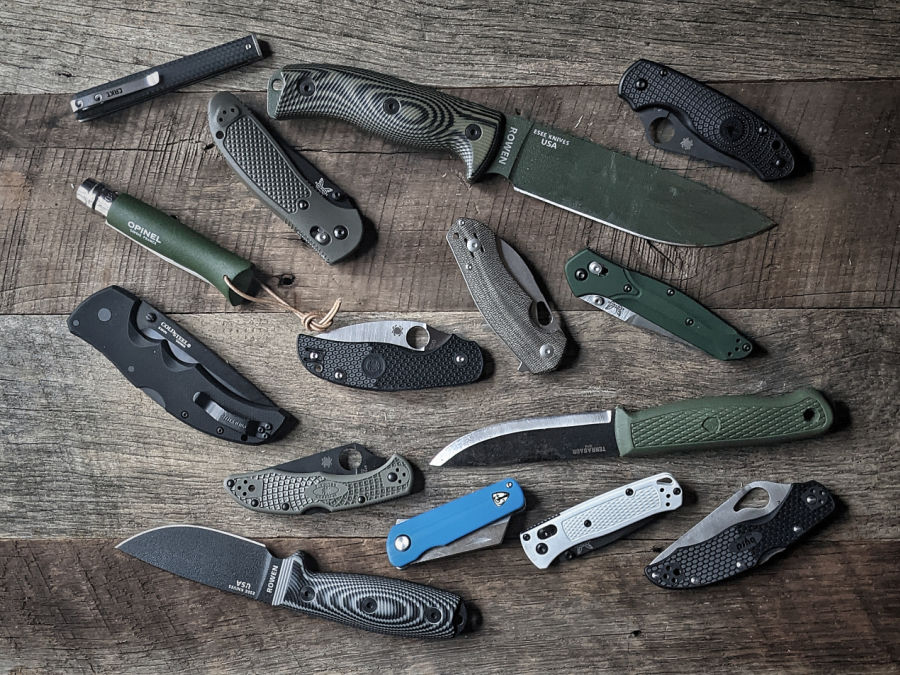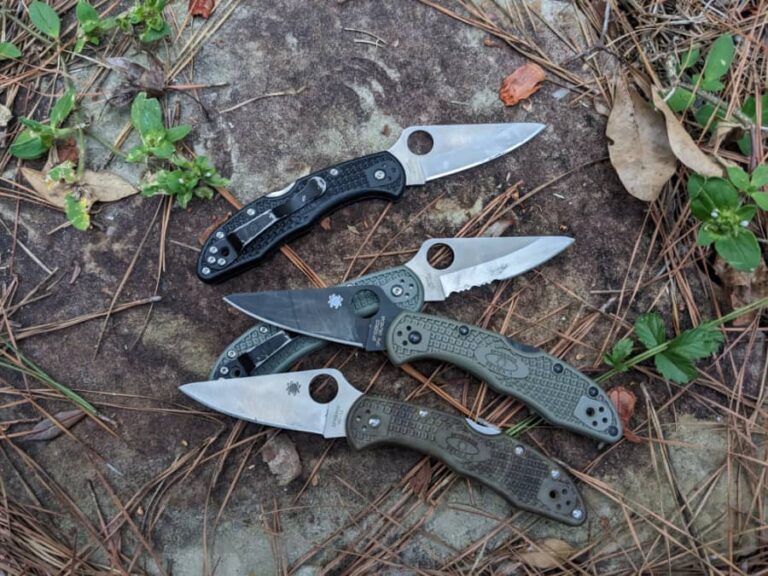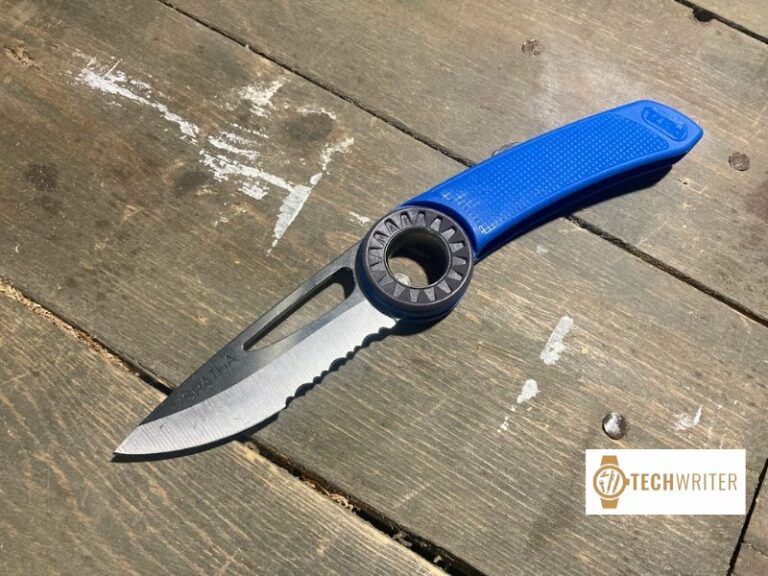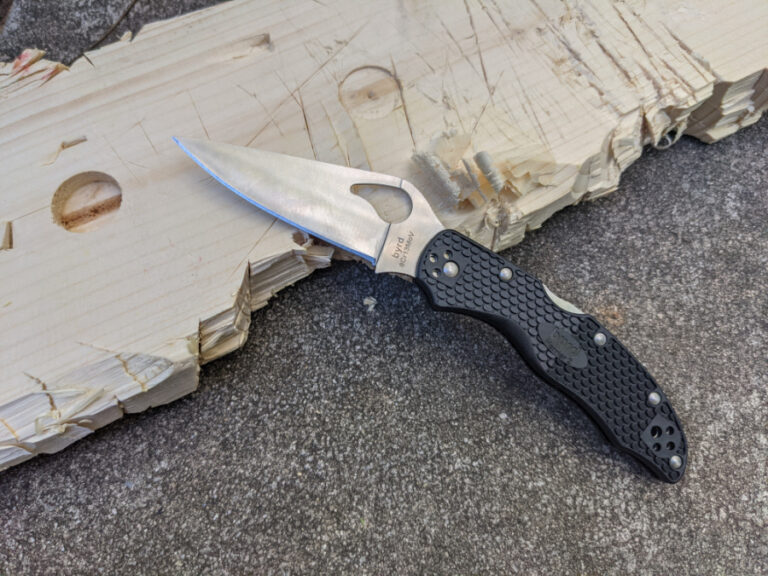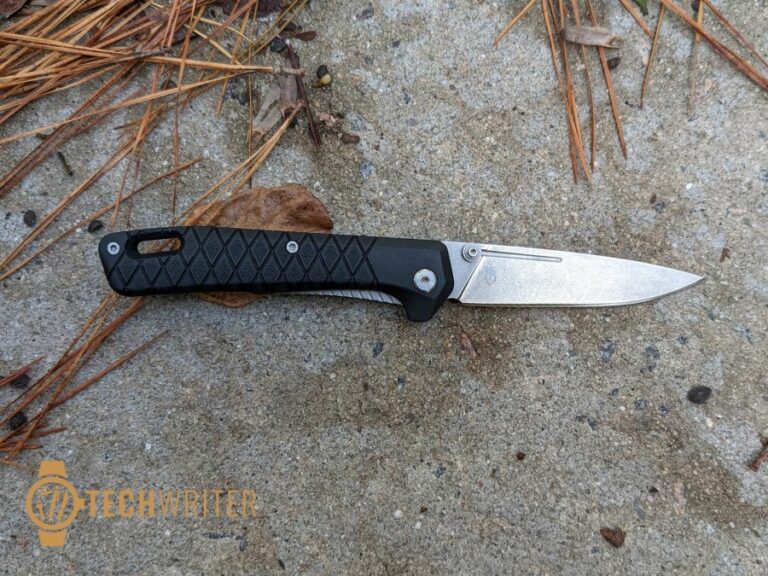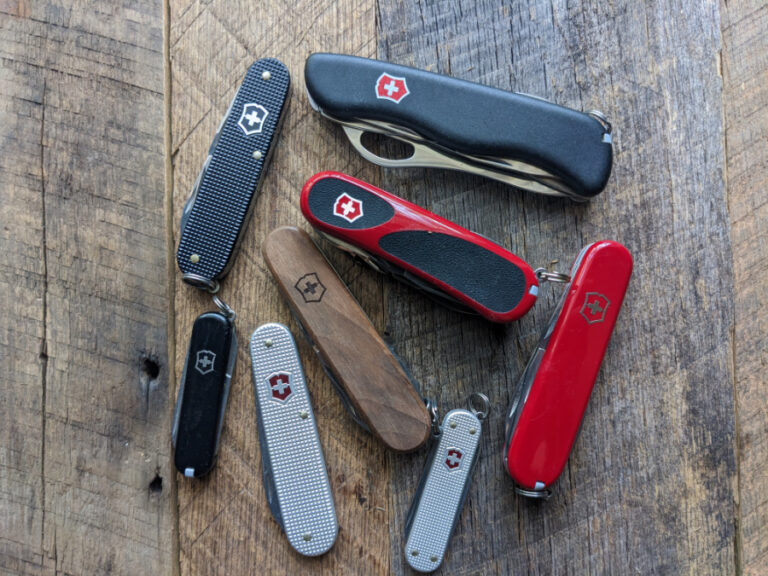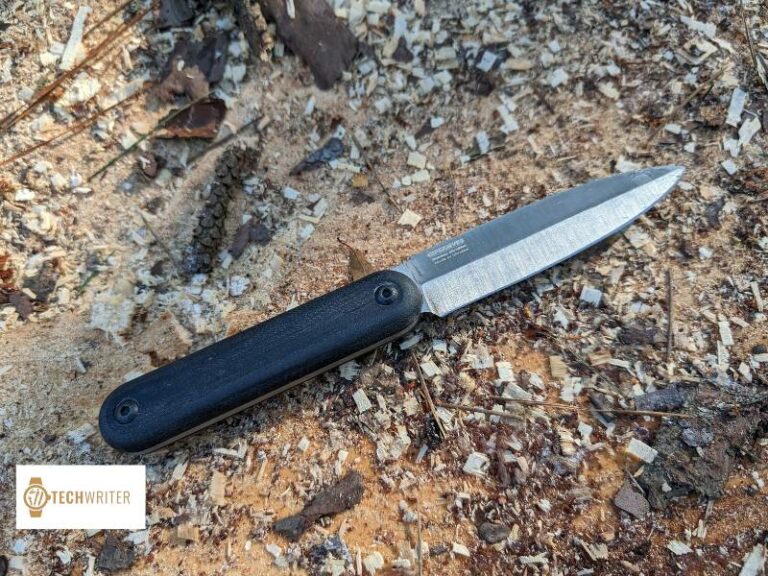Knife Steel Guide | A Compresinve Guide For Blade Steel On EDC Knives and Fixed Blades
Whether you’re buying a pocket folding knife for EDC or a fixed blade hunting knife, you have a lot of options when it comes to types of knife steel. And all those options can be more than a little confusing.
At its most basic, steel is essentially just iron and carbon. But as we all know, it’s not really that simple. Steel manufacturers have developed a dizzying array of compositions and processes that have resulted in more types of steel than ever before.
Which one is best for the knife you want? There may not be an easy answer… but we’ll try our best. Let’s first take a look at the properties of good knife steel, and then break steel down into a few basic categories. Finally, we’ll provide a thorough-as-possible list of the most popular knife steels, along with the properties that make each one unique.
Ready for a deep dive? Here we go.
Properties of Knife Steel
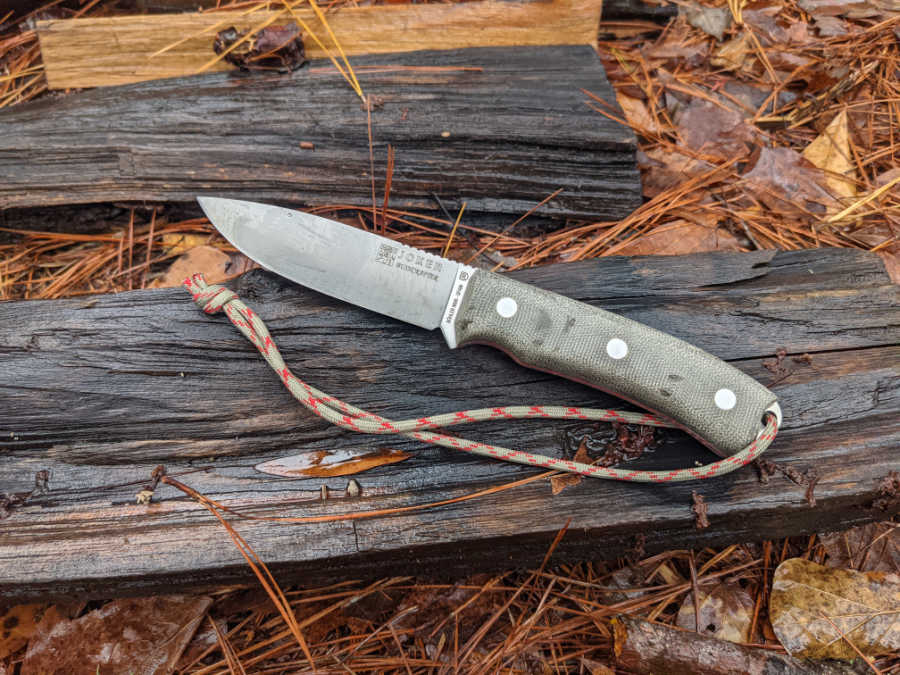
Steel can be judged on any number of qualities, but the following are probably the most widely used. Keep in mind that there’s no such thing as a ‘perfect’ steel that scores a 10/10 in every category listed below. There’s usually a trade-off required, so a steel that scores highly in one property is likely to be lacking in another.
Hardness
Simply put, hardness refers to a material’s ability to resist deformation under stress or impact, (i.e. a blade’s resistance to scratching, abrasion, bending or otherwise deforming). Steel hardness is usually measured using the Rockwell C scale, which is abbreviated as HRC. Most knife steels have an HRC rating between 52 and 64. The higher the number, the harder the steel.
Toughness
Toughness is steel’s resistance to breaking or chipping. Tough steel can take impact without breaking. One of the biggest trade-offs in steel is between toughness and hardness; steel that is higher in one is almost always lower in the other.
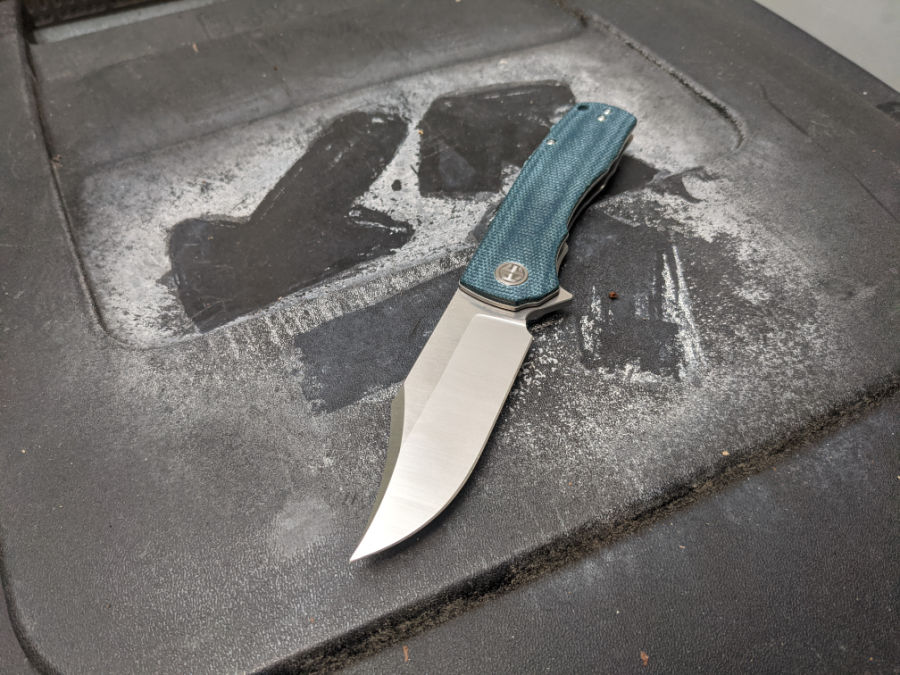
Wear Resistance
When we talk about wear resistance, we’re talking about a blade’s ability to resist abrasive and adhesive wear. There’s a definite correlation between a steel’s hardness and its wear resistance, though hardness is not the only determining factor. Carbide size also plays a role, with steel made up of larger carbides losing toughness and being more resistant to wear.
Corrosion Resistance
Steel’s ability to ward off corrosion—including rust, patina and other staining—is referred to as corrosion resistance. As a general rule, high carbon steels are most vulnerable to corrosion, while stainless steels are more corrosion resistant. This is another area where a trade-off occurs, as carbon steel typically has greater hardness, while stainless has greater toughness.
Edge Retention
As you can probably guess, edge retention refers to a knife’s ability to stay sharp. There’s an argument to be made that “edge retention” is more of a marketing buzzword than a definitive property of steel, since there’s no way to directly measure it in any concrete way. Blades can dull from a multitude of causes, making edge retention a combination of many factors.
Ease of Sharpening
Like edge retention, ease of sharpening is difficult to measure or quantify, but it is important. There’s something of an inverse relationship between ease of sharpening and wear resistance, since a more wear-resistant steel will, by nature, be harder to sharpen.
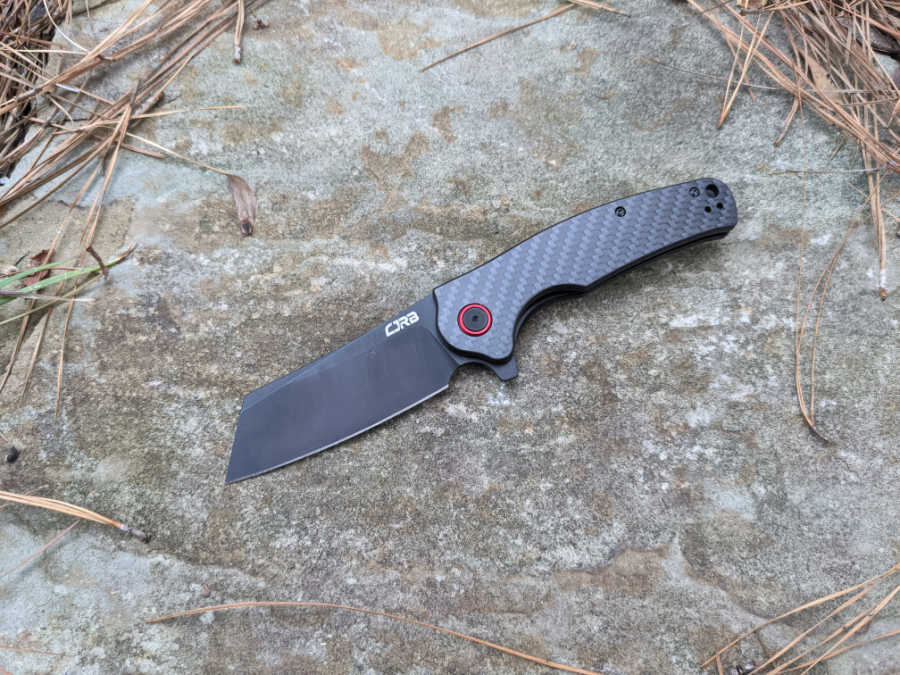
Common Steel Types
Before we get into specific kinds of steel and the properties of each one, let’s start by dividing steel up into a few broad categories. Keep in mind that, while each individual kind of steel in the same category will share certain characteristics, they can also be quite different.
Carbon Steel
Carbon steel is the simplest steel there is, typically consisting of only iron and carbon. If other alloying elements are present, they are present in very low amounts. The advantages of carbon steel are toughness and durability; it can be given an extremely sharp edge, and is usually easy to sharpen. That being said, carbon steel sacrifices some toughness.
Carbon steel can be brittle, making it more likely to break or chip than to bend or deform. It also has low corrosion resistance, making it vulnerable to rust. Carbon steel is often used for machetes and survival knives, though there are some excellent folding knives with carbon steel blades. One of the most common carbon steels is 1095, which is named for its 0.95% carbon content.
Stainless Steel
The addition of chromium to steel increases its corrosion resistance and makes it stainless steel. The traditional rule is that steel must have at least 12% chromium content to be considered stainless, though that rule occasionally gets bent in different ways.
In addition to corrosion resistance, stainless steel typically also exhibits high toughness, but at the expense of hardness. Stainless steels are typically more difficult to sharpen than carbon steels. Pocket knives and kitchen knives are most often made of stainless steel, and some of the more common varieties include the Sandvik, 400, AUS and MoV series steels.
Tool Steel
The basic definition of tool steel is that it’s any type of steel used in tooling, which includes hand tools as well as machine dies that are used to cut other metals and materials, including other kinds of steel. D2 is one of the most common tool steels used for knives. A key feature of tool steel is hardness, which is achieved using high amounts of carbon, along with other hardening elements like silicon and molybdenum.
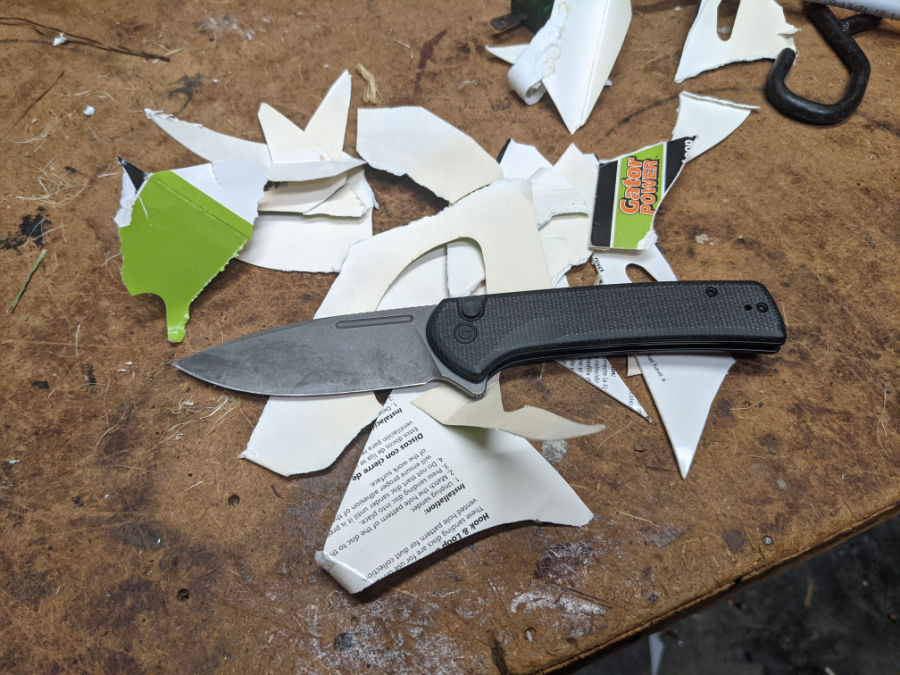
Alloy Steel
Alloy steel is any steel in which the main elements of steel (iron, carbon) are alloyed with between 1% and 50% additional elements. That includes chromium, which means that all stainless steels are alloy steels, but not all alloy steels are stainless.
Damascus Steel
A Damascus steel blade has two or more types of steel that are welded or forged together to create a swirled pattern. There are countless varieties of Damascus steel of varying quality, and although some of them offer exceptional hardness and edge retention, Damascus steel is widely seen as more of an aesthetic choice than a functional one.
Powder Steel
The term “powder steel” refers more to how a steel is made than what it contains, but suffice to say that powder steel tends to be premium, high-alloy steel. Broadly speaking—and keeping in mind that I’m not a scientist—the process of powder metallurgy involves very fine metal powders, which are sprayed tinto the form of a solid ingot.
That’s a vast oversimplification. But in the case of steel, it results in a uniquely uniform structure with smaller carbides and allows a greater range of alloying elements to be incorporated into the steel without losing its workability.
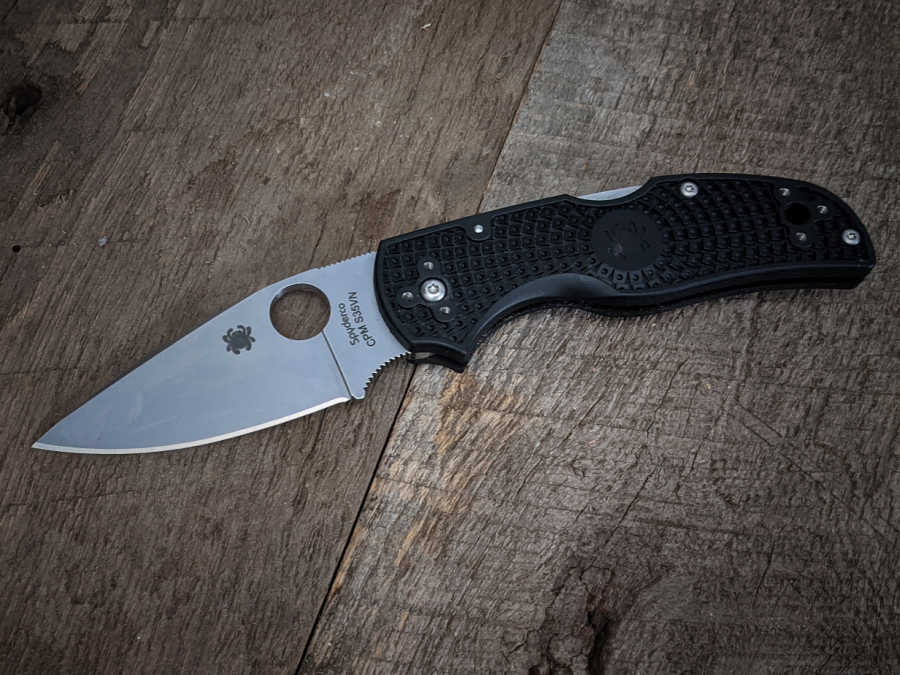
Premium Vs. Budget Steels
It’s often difficult to directly compare types of steel, and I would argue that to call any steel “good” or “bad” is to oversimplify its properties. Having said that, there are definitely certain types of steel that are, overall, better than others.
For the purpose of this guide, steels below are broken down into premium, mid-range and budget categories based on price and performance. But keep in mind that you can get a good knife in virtually any price range, so consider the purpose of the knife you want to get, and look for steel in your budget that has attributes that make it well suited for your intended use.
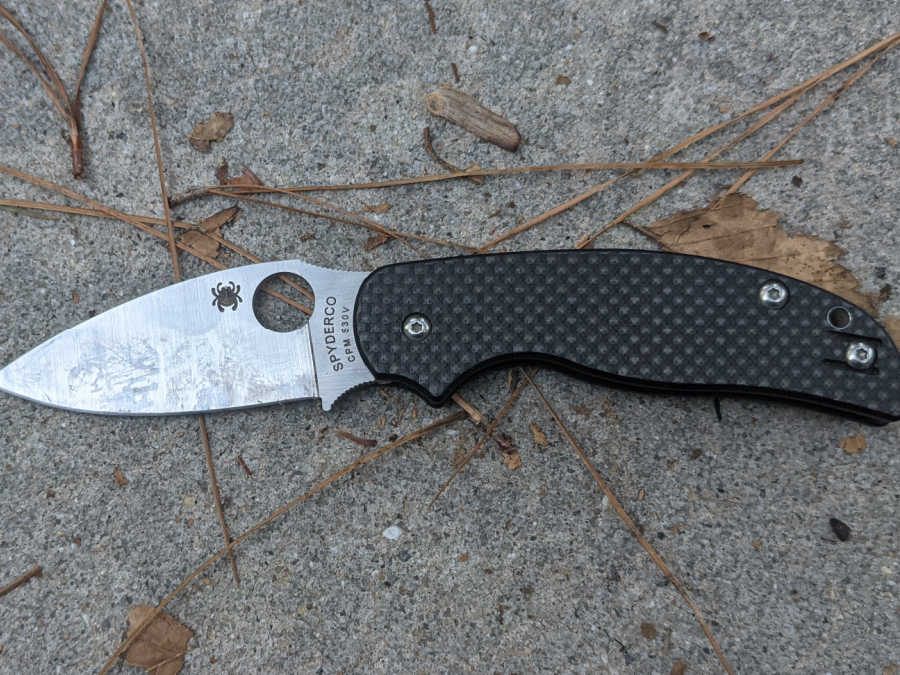
Premium Steel
- M390 – M390 is one of the new crop of “super steels” to come around in recent years. Like a lot of ultra-high-end steels, it’s a powder steel, and it’s made by the Swedish company Bohler. It has phenomenal edge retention thanks to a good amount of chromium, molybdenum, vanadium and tungsten in the mix. It’s very corrosion-resistant as well, but like many premium steels, is quite hard to sharpen.
- Elmax – Made by Austria-based Uddeholm, Elmax steel is in the same general range as M390. It’s an extremely high carbon stainless steel, and contains chromium, vanadium and molybdenum. Elmax falls ever-so-slightly short of M390 in edge retention and corrosion resistance, but is a little easier to sharpen.
- AEB-L – Another Swedish steel from Bohler, AEB-L is noted for its incredible toughness. Small carbides and a very fine grain structure when heat treated make it virtually unbreakable, though the wear resistance and edge retention are just average. It’s easier to sharpen than most premium steels.
- CTS-XHP – U.S.-based Carpenter Technology makes CTS-XHP stainless, a powder metallurgy steel, which is used in everything from pocket knives to surgery tools and high-end cutlery. It’s sometimes compared to D2, but has higher corrosion resistance and slightly better toughness and edge retention.
- Maxamet – Another one from Carpenter, Maxamet is capable of very high hardness, and is virtually unrivaled when it comes to edge retention. It’s also vulnerable to corrosion and next-to-impossible to sharpen. Spyderco uses Maximet some of its high-end knives.
- ZDP-189 – Japanese ZDP-189 is unique in that it’s stainless while also offering high hardness thanks to being loaded with carbon. It’s most common in high-end chefs’ knives, but occasionally turns up in pocket folders too.
- CPM-S30V – Quite a few premium steels are made in the USA by Crucible Industries, each with names that start with “CPM” (an abbreviation for Crucible Particle Metallurgy). I’m not going to list every single one of their steels because there are just too many, but CPM-S30V, which could be called their flagship steel, is worth noting. It’s one of the more affordable premium steels, and offers a great balance of hardness, toughness and edge retention.
- CPM-S45VN – In 2009, the folks at Crucible upgraded their CPM-S30V steel with finer grain structure and a dash of niobium to create the slightly-superior CPM-S35VN. Ten years later they came out with CPM-S45VN, which has a bit more chromium and thus better corrosion resistance, along with the same toughness and edge retention.
- CPM Magnacut – Introduced in 2021, CPM Magnacut is one of the latest “super steels” to hit the marketplace. It’s a powder steel that’s both stainless and high carbon (molybdenum, vanadium, nitrogen and niobium are also in the mix) and it impresses with its hardness, toughness, edge retention and corrosion resistance. The only trade-off is that it’s (unsurprisingly) hard to sharpen.
- CPM-S110V – I’ll mention one last entry into Crucible’s “CPM series,” and that’s CPM-S110V. This one goes all-in on edge retention and wear resistance, with exceptional hardness and corrosion resistance to boot. It falls short in toughness, so it’s not for hard use, but for sheer cutting ability over the long haul, there’s nothing like it.
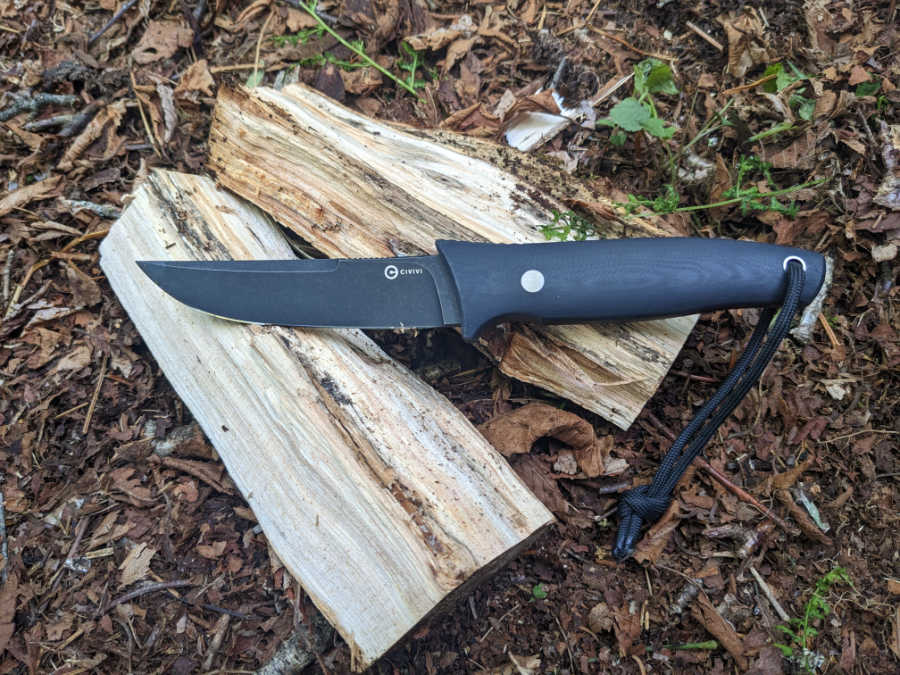
Mid-Range Steel
- D2 – Often referred to as “semi-stainless” because its chromium content falls just short of the definition of true stainless, D2 is a really good compromise between carbon steel and stainless steel. D2 has excellent hardness and edge retention, along with pretty good corrosion resistance. On the flipside, it lacks toughness and is difficult to sharpen. It has become a very popular mid-range option.
- 154CM – Considered high-end when it was first introduced, 154CM remains an all-around solid mid-range stainless steel, with molybdenum in its alloy, which gives it good edge retention compared to 400-series steels. It’s American-made by Crucible Industries.
- H1 – Made in Japan by Myodo Metals, H1 stainless steel has some serious pros and cons. On one hand, it’s about as impervious to corrosion as steel gets. On the other, its edge retention is quite poor. But hey, at least it’s easy to sharpen.
- VG-10 – More common in kitchen knives than EDC or bushcraft knives, VG-10 is a Japanese stainless steel that has high carbon and chromium content, making it hard and rust-resistant, respectively. A bit of vanadium in the mix makes VG-10 harder than 154CM and ATS-34, which it is otherwise quite similar to. It also has a good balance of edge retention and ease of sharpening.
- 1095 – This one is right on the line between budget and mid-range, but I’ll bump it up because it’s superior to its lower-end counterpart, 1075. They’re both 10-series carbon steels, and the last two numbers represent the carbon content (1095 = 0.95% carbon). 1095 is the most popular carbon steel for bushcraft knives because it’s tough, resists chipping, and sharpens easily. Its edge retention is modest at best, and like all carbon steels, is susceptible to rust.
- 13C26 – Made in Sweden by Sandvik, 13C26 stainless steel was originally developed for razor blades. It has excellent hardness and edge retention, and can be sharpened to an exceptionally fine edge. The corrosion resistance is good but not great.
- 14C28N – Another Swedish-made stainless steel from Sandvik, 14C28N is essentially an improved version of 13C26 that was developed for Kershaw knives. It has more chromium and less carbon than its predecessor, along with nitrogen for better corrosion resistance. It sacrifices a bit of edge retention, but has excellent toughness and is quite easy to sharpen.
- A2 – A tool steel that falls in between what would be considered carbon steel and stainless steel, A2 is quite similar to D2, though it is less widely used. A2 is tougher than D2, but not as hard or wear-resistant.
- ATS-34 – Essentially the Japanese equivalent to 154CM, ATS-34 is a mid-range stainless steel with very good edge retention, but lower corrosion resistance than most stainless steels.
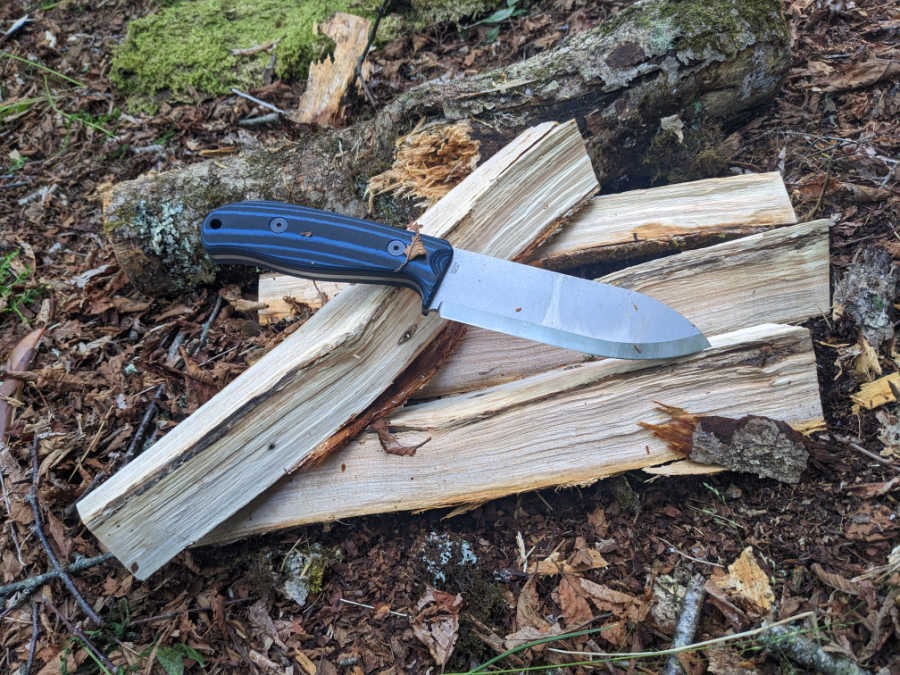
Budget Steel
- 420HC – The 400 series of stainless steels includes numerous variations on what is essentially basic, affordable stainless steel. 420HC is one of the most widely used in pocket folders (most famously in Buck knives), and offers excellent corrosion resistance and toughness. Its edge retention isn’t the best, but it’s pretty easy to sharpen. The “HC” stands for high carbon, though its actual carbon content barely qualifies for that distinction.
- 440A – Here’s another entry into the very common 400 series. The chief difference between 240HC and 440A is that 440A has greater carbon content, which gives it better edge retention and wear resistance.
- 440C – Another step up from 440A, 440C has even more carbon in its composition. That gives it just about the best hardness and edge retention you’ll find in a 400-series stainless steel, though its corrosion resistance is somewhat lower than its counterparts.
- AUS-8 – At the upper end of what would be considered “low end” stainless steel, Japanese-made AUS-8 is similar to 440 stainless steel, but with additional vanadium, which gives it improved hardness. AUS-8 is also quite easy to sharpen, though it lacks edge retention.
- 8Cr13MoV – A budget-priced stainless steel that is made in China, 8Cr13MoV has become widely used in everyday carry blades. It scores modest marks in every category, and doesn’t have any standout features. It’s very similar to AUS-8, but with more carbon. Spyderco uses it in many of their Chinese-made knives, and it can be decent with the right heat treatment.
- 1075 – The only real difference between 1075 carbon steel and 1095 carbon steel is that 1075 has less carbon (0.75%, to be exact) which makes it even more vulnerable to corrosion. It does offer good toughness and is very easy to sharpen, though its edge retention is not the best.
- CTS-BD1 – An entry-level stainless steel that is often compared to AUS-8 and 8Cr13MoV, CTS-BD1 is made by US-based Carpenter Technology. It has good edge retention and corrosion resistance, decent toughness, and is fairly easy to sharpen.
- CTS-BD1N – Also made by Carpenter, CTS-BD1N is essentially the same as CTS-BD1, but with added nitrogen which increases hardness while slightly reducing toughness.
Choosing the right type of knife steel is an essential task that requires a nuanced understanding of the properties, characteristics, and applications of various steels. Whether you’re in the market for a versatile EDC folder or a robust hunting knife, the steel you choose can greatly influence the tool’s performance, longevity, and ease of maintenance.
Remember, the ‘best’ steel is subjective and highly dependent on your specific needs. From high-carbon steels renowned for their edge retention to stainless steels praised for their corrosion resistance, each type has its own set of advantages and disadvantages. Take the time to consider factors like hardness, toughness, wear resistance, and corrosion resistance in relation to your intended use for the knife.
I hope this guide has helped demystify the complex world of knife steels, providing you with the knowledge you need to make an informed decision. Whether you opt for a tried-and-true classic like 1095 carbon steel or explore newer, high-tech options like CPM-S90V, your understanding of what each type brings to the table will ensure that you end up with a knife that’s not just good, but perfect for you.
Happy knife hunting!
Check Out The Top Selling Spyderco Pocket Knives On Amazon. This Is A Live List And Changes All The Time:
- Game Changer: Being tenacious means you are persistent and cohesive. It’s being tough and tireless in achieving your best performance; all worthy descriptive words for a hard-use knife
- Superior Blade Steel: The 3.39″ 8Cr13MoV stainless blade is ground-flat from the spine to cutting-edge for non-stop cutting
- A Secure Grip: This all-new lightweight version raises the bar even further with injection-molded fiberglass-reinforced-nylon (FRN) handle scales that reduce the knife’s overall weight by almost 12 percent.
- Easy-To-Use: The blade’s shape coupled with an oversized Spyderco Round Hole and textured spine jimping allows you to open the blade and position your thumb on the spine in slip-proof confidence ready for work.
- Pocket-Friendly: The Tenacious includes a Walker Linerlock and a black 4-way pocket clip lets the folder be set in a variety of carry and draw positions: Tip-up/tip-down left-hand/right-hand.
- An Improved Classic: Undeniably one of Spyderco’s most popular and in-demand designs, the Para Military 2 distills the world-class performance of our legendary Military Model into a more compact, Pocket-Friendly package.
- Superior Quality: We kept the same high-performance full flat-ground blade but we capitalized it with CPM CRU-WEAR steel which has a superior edge while remaining tough and resilient.
- A Secure Grip: The Micarta’s layered handle is narrowed at the end improving the Ergonomics. The handle and blade have been profile thinner; removing uncomfortable angles when in the closed position.
- Easy-to-Use: The Para Military 2 features extreme strength, reliability, and ease of use of our patented Compression Lock mechanism and versatility of a 4-position pocket clip.
- Dependable: Refinements to overall construction may not be drastic but from the G-10 textured handle to the steel full flat blade, everything is sharper, smoother and guaranteed to provide performance and user comfort.
- Game Changer: Being tenacious means you are persistent and cohesive. It’s being tough and tireless in achieving your best performance; all worthy descriptive words for a hard-use knife.
- Superior Blade Steel: The 3.39″ 8Cr13MoV stainless blade is coated in a non-reflective black coating and ground-flat from spine to cutting-edge for non-stop cutting.
- A Secure Grip: It has a black G-10 laminate handle, Ergonomically milled with prolonged fatigue-free cutting in mind.
- Easy-To-Use: The blade’s shape coupled with an oversized Spyderco Round Hole and textured spine jimping allows you to open the blade and position your thumb on the spine in slip-proof confidence ready for work.
- Pocket-Friendly: The Tenacious includes a Walker Linerlock and a 4-way pocket clip lets the folder be set in a variety of carry and draw positions: Tip-up/tip-down left-hand/right-hand.
- Wide Spectrum of Handle Colors: The Delica 4 now offers new vibrant tones including blue, green, brown, gray, orange, zome green, black and purple.
- Superior Blade Steel: The blades are full flat-ground VG-10 Steel with a thinner highly refined cutting edge and a larger 13mm opening hole.
- Ultra-Lightweight: Inside the handle are dual skeletonized Stainless Steel liners which strengthen the knife without additional weight and double as an anchor for external and internal components to attach through generating more sturdiness.
- Ergonomic: Added to the blade’s spine is slip resistant jimping. Phosphor bronze washers smooth out the open/close action and the clip is upgraded to a four-way tip-up, tip-down, left-or right-handed clip.
- A Secure Grip: Molded onto the FRN Handle’s surface is Bi-Directional Texturing for slip-free tactile traction. It provides resistance to slipping in the hand.
- The New EDC: The Para 3 distills all the features of that best-in-class folding knife into a more compact, carry-friendly package. Ounce for once one of the most capable folding knives ever made, the Para 3 is destined to be a classic.
- Superior Quality: Machined from premium CTS BD1N, a nitrogen-enriched high-carbon chromium steel, the Para 3 offers superior balance, edge retention, and low-friction cutting performance.
- Pocket-Friendly: It features a lightweight, open-backed construction style and its Stainless Steel liners are nested into the FRN Handle. This reduces handle thickness and provides excellent support for the knife’s Compression Lock.
- Reliable High Performance: The Para 3 traces its history all the way back 2004 to the introduction of the Para Military design. It offers the same proven reliability and cutting performance, but in a more compact, easy-to-carry design.
- Easy-to-Use Lock: Located in the spine of the handle, the Compression Lock’s high-strength mechanism locks the blade securely open during use, yet allows it to be closed easily and safely with only one hand.
- One of a Kind: Based on Kevin Smock, visionary industrial designer, the Spyderco Smock translates his innovative style into a premium-quality production folder.
- Enhanced Safety: The flipper action is supported by a pair of special ball-bearing pivot washers and a dedicated secondary detent mechanism separate from the knife’s lock.
- Extreme Lock Strength: The Smock’s most unique feature, however, is the button release on its high-strength Compression Lock mechanism, which allows the knife to be safely and easily closed without placing your fingers near the blade’s edge.
- Ultra-Lightweight: It is paired with a skeletonized handle featuring full Stainless Steel liners, textured carbon fiber/G-10 laminate scales, lightweight, open-backed construction, and a reversible, tip-up pocket clip for ambidextrous carry.
- Superior Quality: The hollow-ground blade of this knife is precision machined from CPM S30V Stainless Steel and includes both a Trademark Round Hole and an elegantly understated flipper opener.
- An Improved Classic: Undeniably one of Spyderco’s most popular and in-demand designs, the Para Military 2 distills the world-class performance of our legendary Military Model into a more compact, Pocket-Friendly package.
- Superior Quality: We kept the same high-performance full flat-ground blade but we’ve also lengthened the blade’s tip and added additional surface jimping to both the spine and finger coil.
- A Secure Grip: The G-10 handle is narrowed at the end improving the Ergonomics. The handle and blade have been profile thinner; removing uncomfortable angles when in the closed position.
- Easy-to-Use: The Para Military 2 features extreme strength, reliability, and ease of use of our patented Compression Lock mechanism and versatility of a 4-position pocket clip.
- Dependable: Refinements to overall construction may not be drastic but from the G-10 textured handle to the steel full flat blade, everything is sharper, smoother and guaranteed to provide performance and user comfort.
- Ready For Anything: The Manix 2 is an extremely capable full-sized folder that is known for it’s strength and performance. Its broad blade provides exceptional cutting power, while its textured index finger choil and thumb ramp allow a forward grip.
- A Secure Grip: It’s scaled G-10 handle has a unique non-slip checked texture. This handle provides a special kind of comfort, creating a reliable, long-term carry.
- Dependable: If you are looking for control and precision, look no more. This knife features our PlainEdge grind which is known for creating a smooth and exact cut.
- Low Friction: This knife features a blade ground with flat bevels that extend from the spine all the way to the cutting edge. This grind reduces drag during cutting and decreases overall weight.
- High-Strength Lock: The Ball Bearing Lock features a patented compressive lock that wedges a ball bearing between a fixed anvil and the blade tang. The mechanism also serves as a detent to hold the blade in the closed position.
- Game Changer: Being tenacious means you are persistent and cohesive. It’s being tough and tireless in achieving your best performance; all worthy descriptive words for a hard-use knife.
- Superior Blade Steel: The 3.39″ 8Cr13MoV stainless blade is coated in a non-reflective black coating and ground-flat from spine to cutting-edge for non-stop cutting.
- A Secure Grip: It has a black G-10 laminate handle, Ergonomically milled with prolonged fatigue-free cutting in mind.
- Easy-To-Use: The blade’s shape coupled with an oversized Spyderco Round Hole and textured spine jimping allows you to open the blade and position your thumb on the spine in slip-proof confidence ready for work.
- Pocket-Friendly: The Tenacious includes a Walker Linerlock and a 4-way pocket clip lets the folder be set in a variety of carry and draw positions: Tip-up/tip-down left-hand/right-hand.
- Superior Quality: The Yojimbo 2 is an evolved expression of its original Spyderco Yojimbo design. The refined Ergonomics of the Yojimbo 2 complement the natural contours of the hand, ensuring maximum surface contact and positive control.
- Versatile: A unique attribute of the Yojimbo 2 is the thumb forward grip. It allows the 3.2″ CPM S30V blade to feel like a natural extension of the hand.
- Ergonomic: The PlainEdge straight cutting edge of the hollow-ground blade offers extreme cutting performance by transferring power all the way to the tip and ensures improved point strength.
- A Secure Grip: Our Yojimbo 2 features a textured G-10 handle and a four-position clip which allows a non-slip grip and rapid deployment from all carry position.
- Durable: The Yojimbo 2 has nested Stainless Steel liners which provide structural strength and form the backbone of the knife’s high-strength Compression Lock mechanism.

Blair Witkowski is an avid watch nut, loves pocket knives and flashlights, and when he is not trying to be a good dad to his nine kids, you will find him running or posting pics on Instagram. Besides writing articles for Tech Writer EDC he is also the founder of Lowcountry Style & Living. In addition to writing, he is focused on improving his client’s websites for his other passion, Search Engine Optimization. His wife Jennifer and he live in coastal South Carolina.

